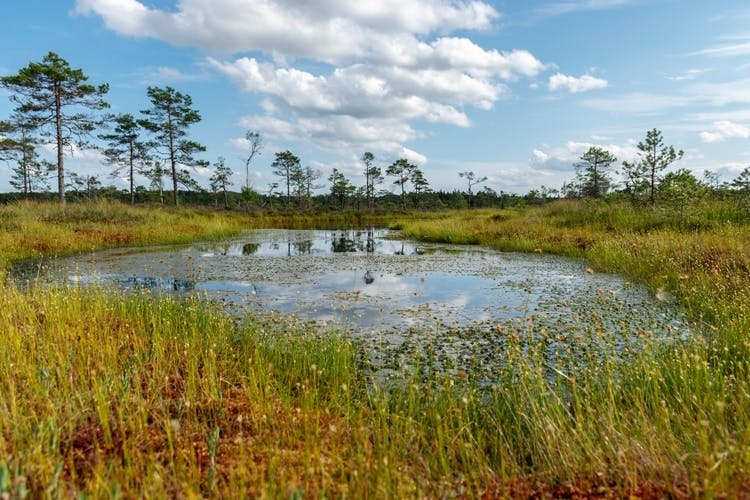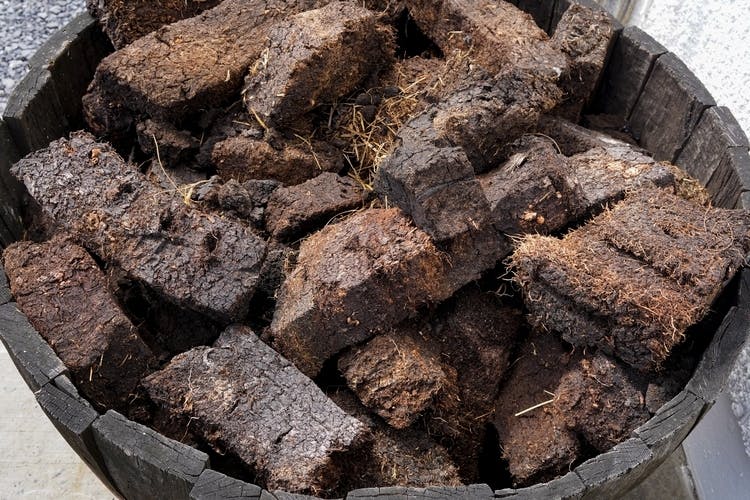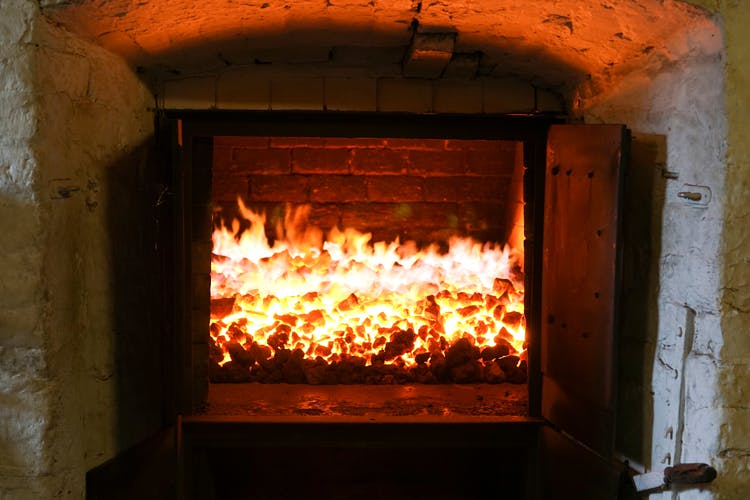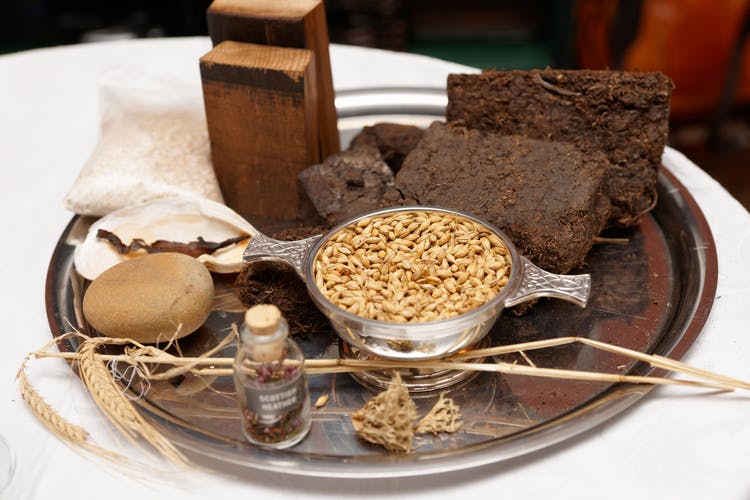
"Smoky," "salty," "peaty"... Peated whisky holds a unique place in the vast world of whisky and its many variations. Appreciated for its distinctive character, it is famous for its smoky aromas, maritime nuances, vegetal, medicinal, and even camphor-like notes.
This variety of whisky forms a category of its own, attracting a dedicated audience who, in some cases, are exclusively loyal to it.
But what are the origins of its distinctive traits?
In this article, we will detail what gives whisky its particularly smoky taste.
What is peat?
Peat is a natural fuel resulting from the very slow decomposition of plants (a peat bog gains on average 1 millimeter per year).
In the Lowlands or Speyside, peat, being less compact, is rich in plant matter such as heather, ferns, roots, pines, etc. On the coast or on islands like Islay or Arran, peat is denser in marine elements like algae, salt, or sand.
Although it remains a minority in whisky production worldwide, peat plays a crucial role in the malting process of barley in certain regions of Scotland, directly influencing the aromatic profile and tasting experience of the whisky.
After germination, the malted barley is dried in a kiln, a perforated metal floor placed above a chimney, where the combustion of the peat produces dense and aromatic smoke that imparts its flavors to the whisky.

In the north and west of Scotland, vast expanses of peat have accumulated to depths of several meters. On the island of Islay, some peat bogs are over 10,000 years old.
In fact, the harvesting of peat, just like the harvesting of barley, was a key moment in the annual activity of a distillery until the late 1950s. Once extracted, the peat must be dried before being used, a process essential for its effectiveness during the malting of barley.
From the end of spring through the summer, when the mild climate no longer allowed for distillation, workers would harvest the peat from the bogs. This task, now obsolete, is still carried out in the Orkney Islands and on the island of Islay.
Peat in whisky production
In the production of peated whisky, the drying of the barley, the final step in malting, is crucial and gives the whisky its famous smoky notes.
Traditionally, this operation took place in a kiln, which is still preserved by some distilleries as a decorative element. The kilns housed under their pagoda-shaped roofs fireplaces fueled by coal and peat, on which the malt was dried.
When the malt is still damp, it particularly absorbs the phenols present in the smoke, which are responsible for the peaty flavor.

It is then the duration of exposure to phenols that will determine the intensity of the peaty flavor in the malt, and thus in the whisky.
The advent of mechanical malting introduced the use of new fuels, such as natural gas and fuel oil, thereby improving the control of drying temperatures and preserving the essential enzymes in the malt.
A meticulous process
Depending on the moisture content of the malt, the drying can last between 25 and 40 hours, and it is during the first few hours of this operation that peat is used.
Due to its very high moisture content, which can range from 25% to 60%, peat, when burned in the kiln, produces very little heat but generates thick, greasy smoke that partly dries the malt, but more importantly, imparts specific smoky aromas as well as notes of earth, tar, vegetation, or iodine, for example.
It is crucial that the temperature does not exceed 50°C to prevent damage to the malt’s enzymes.
After reducing the grain’s moisture from 45% to 25%, a change of fuel is made to finalize the drying of the barley.
The dried malt, with a residual moisture content of 4% to 6%, is then stored in silos. To quantify the phenolic content of the malt, the unit of measurement used is ppm (parts per million).
Different levels of peated whisky
When we talk about a lightly peated or heavily peated whisky, we are generally referring to a threshold for each of these classifications.
Lightly peated whiskies typically use malt with 2 to 10 ppm of phenols, while heavily peated whiskies often use malt with up to 50 ppm of phenols. The record reached is 307 ppm of phenols, by an Octomore bottling from the Bruichladdich distillery on Islay.

However, it is important to note that the influence of peat on the flavors of the whisky diminishes as the maturation process progresses.
After 10 years in cask, the whisky loses about half of its peat level.
In practical terms, a malt with 50 ppm of phenols drops to around 25 ppm of phenols after 10 years of cask aging.
Talking about the peat level can therefore be misleading, as it is only after the malting stage that this level is measured.
The ppm level measured in the distillate, and then in the matured whisky, will be much lower.
What aroma does peat give to whisky?
The combustion of peat produces phenols, particularly cresols and xylenols (organic compounds that belong to the phenol family).
The intensity of the aromas conveyed by peat smoke depends on the amount of peat used to dry the malt and the burning temperature. The most distinctive aromas are those of licorice, chimney fire, ash, but also cloves, camphor, and eucalyptus.
At the extreme, peated whiskies develop aromas of smoked fish, oysters, and even burnt rubber.
Today, the malted peated barley used by the seven distilleries on the island of Islay primarily comes from the Port Ellen malting facility.
Approximately 2,000 tons of peat are used each year to produce the malt used in the creation of their single malts.
Our selection of the best peated whiskies
The Kilchoman distillery
KILCHOMAN Machir Bay

59.9 €
Kilchoman Machir Bay
Machir Bay, beyond being an iconic expression of Kilchoman, takes its name from a beach located immediately near the distillery on the island of Islay.
This single malt is the result of a careful blend of whiskies that have matured 90% in first-fill bourbon casks and 10% in Oloroso sherry casks. It presents a fresh, herbal profile with citrus notes and, of course, powerful peaty aromas of smoke and ash.
The peated malt with 50 ppm of phenols used for this bottling comes from the Port Ellen malting facility, but Kilchoman also produces a limited-edition 100% Islay version, using locally malted and peated barley, traditionally done by the distillery itself!
The Lagavulin distillery
LAGAVULIN 16 ans

109.9 €
Lagavulin 16 years old
This single malt whisky, originating from the renowned Islay island, is distinguished by its high peat content and saline character, and is part of the illustrious Classic Malts collection.
Aged in bourbon casks, this essential malt captures the very essence of its distillery. It reveals a smooth and smoky profile, enriched with notes of seaweed and dried fruits.
The Caol Ila distillery
CAOL ILA 12 ans

55 €
Caol Ila 12 years old
An iconic peated single malt from the island of Islay, Caol Ila takes its Gaelic name from the Sound of Islay, the sea channel that separates Islay from its neighbor Jura, set in the heart of the wild and preserved landscape of the Scottish west coast.
Its single malt is distinguished by a subtle balance between saline and peaty notes, enhanced by aromas of olive oil, almonds, and citrus.
La distillerie Laphroaig
Laphroaig 16 years old 2005 Antipodes
A must-have for peated whisky enthusiasts with a salty touch, this great classic from the island of Islay stands out immediately.
Its color, a deep gold with hints of green reflections, precedes a generous bouquet where medicinal, saline, and wild peat dominate.
A very distinctive character that delights the fans of this legendary distillery!
F.A.Q
What is PPM?
PPM, or "parts per million," is a measure used to quantify the phenolic content of the malted barley used in the production of peated whisky.
Phenols are chemical compounds that contribute to the peaty flavor of a whisky. The PPM level of phenols indicates the amount of these phenolic compounds present in the malt, influencing its peaty aroma profile.
A high PPM (30 PPM of phenols or more) means a very peaty and smoky whisky, while a lower PPM (10 PPM of phenols or less) indicates a more subtle profile.
How to recognize the peaty taste in whisky?
The peaty taste of a whisky can be identified by its unique aromatic signature, often described as smoky, earthy, or evoking notes of tar, vegetation, iodine, or salt, etc.
These aromas come from the phenolic compounds absorbed by the barley during the drying process over a peat fire.
To recognize the peaty flavor, you should pay attention to these smoky nuances and the richness of secondary flavors, which can vary depending on the type of peat used and the region from which the whisky originates.
What foods pair well with peated whisky?
In general, peated whisky pairs well with foods that have equally strong and bold flavors:
- Smoked and grilled meats
- Seafood
- Strong cheeses
- Dark chocolate
TO EXPLORE WHISKIES FURTHER
La Maison du Whisky has three boutiques in Paris:
In each of these boutiques, you'll find a wide selection of whiskies, rums, sakes, and other fine spirits.
Because a whisky can be described in a thousand words, our experts will be delighted to guide you through the must-try whiskies at La Maison du Whisky.
Follow our tasting calendar for upcoming events, or visit the Golden Promise Whisky Bar, which offers an extensive selection of whiskies and other spirits by the glass.
Written by
- Quentin JEZEQUEL - SEO project manager at LMDW.
Verified by
- Didier GHORBANZADEH - Wine & Spirits Expert at LMDW
- Clotilde NOUAILHAT - Editorial and Corporate Communications Manager at LMDW
